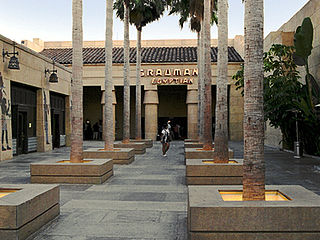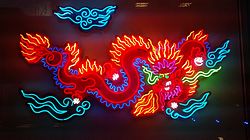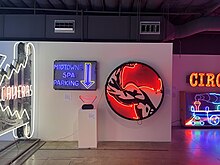
Glendale is a city in the San Fernando Valley and Verdugo Mountains regions of Los Angeles County, California, United States. At the 2020 U.S. Census the population was 196,543, up from 191,719 at the 2010 census, making it the fourth-largest city in Los Angeles County and the 24th-largest city in California. It is located about 10 miles (16 km) north of downtown Los Angeles.

Grauman's Egyptian Theatre is a historic movie theater located on Hollywood Boulevard in Hollywood, Los Angeles, California. Opened in 1922, it is an early example of a lavish movie palace and is noted as having been the site of the first-ever Hollywood film premiere. From 1998 until 2020, it was owned and operated by the American Cinematheque, a member-based cultural organization.

Chinatown is a neighborhood in Downtown Los Angeles, California, that became a commercial center for Chinese and other Asian businesses in Central Los Angeles in 1938. The area includes restaurants, shops, and art galleries, but also has a residential neighborhood with a low-income, aging population of about 7,800 residents.

Hollywood Boulevard is a major east–west street in Los Angeles, California. It runs through the Hollywood, East Hollywood, Little Armenia, Thai Town, and Los Feliz districts. Its western terminus is at Sunset Plaza Drive in the Hollywood Hills and its eastern terminus is at Sunset Boulevard in Los Feliz. Hollywood Boulevard is famous for running through the tourist areas in central Hollywood, including attractions such as the Hollywood Walk of Fame and the Ovation Hollywood shopping and entertainment complex.

The Alex Theatre is a landmark located at 216 North Brand Boulevard in Glendale, California, United States. It is currently owned by the city of Glendale and operated by SAS. The theater's capacity is 1,400.
The Glendale Unified School District is a school district based in Glendale, California, United States.

The Los Angeles LGBT Center is a provider of programs and services for lesbian, gay, bisexual and transgender people. The organization's work spans four categories, including health, social services, housing, and leadership and advocacy. The center is the largest facility in the world providing services to LGBT people.
Outfest is an LGBTQ-oriented nonprofit that produces two film festivals, operates a movie streaming platform, and runs educational services for filmmakers in Los Angeles. Outfest is one of the key partners, alongside the Frameline Film Festival, the New York Lesbian, Gay, Bisexual, & Transgender Film Festival, and the Inside Out Film and Video Festival, in launching the North American Queer Festival Alliance, an initiative to further publicize and promote LGBT film.

The Broadway Theater District in the Historic Core of Downtown Los Angeles is the first and largest historic theater district listed on the National Register of Historic Places (NRHP). With twelve movie palaces located along a six-block stretch of Broadway, it is the only large concentration of movie palaces left in the United States. The same six-block stretch of Broadway, and an adjacent section of Seventh Street, was also the city's retail hub for the first half of the twentieth century, lined with large and small department stores and specialty stores.
Margi Scharff was an American artist. Among her better known pieces were The Night Room, Pillar of Warmth and A Series of Miscellaneous Connections. Scharff was given to using found objects in her art.

Vista Theatre is a historic single-screen movie theater in Los Angeles, California, located in Los Feliz on the border with East Hollywood.
Laura Aguilar was an American photographer. She was born with auditory dyslexia and attributed her start in photography to her brother, who showed her how to develop in dark rooms. She was mostly self-taught, although she took some photography courses at East Los Angeles College, where her second solo exhibition, Laura Aguilar: Show and Tell, was held. Aguilar used visual art to bring forth marginalized identities, especially within the LA Queer scene and Latinx communities. Before the term Intersectionality was used commonly, Aguilar captured the largely invisible identities of large bodied, queer, working-class, brown people in the form of portraits. Often using her naked body as a subject, she used photography to empower herself and her inner struggles to reclaim her own identity as “Laura”- a lesbian, fat, disabled, and brown person. Although work on Chicana/os is limited, Aguilar has become an essential figure in Chicano art history and is often regarded as an early "pioneer of intersectional feminism” for her outright and uncensored work. Some of her most well-known works are Three Eagles Flying, The Plush Pony Series, and Nature Self Portraits. Aguilar has been noted for her collaboration with cultural scholars such as Yvonne Yarbo-Berjano and receiving inspiration from other artists like Judy Dater. She was well known for her portraits, mostly of herself, and also focused upon people in marginalized communities, including LGBT and Latino subjects, self-love, and social stigma of obesity.
The Los Angeles metropolitan area has a significant Armenian American population. As of 1990, this single area holds the largest Armenian American community in the United States as well as the largest population of Armenians in the world outside Armenia.

The conservation and restoration of neon objects is the process of caring for and maintaining neon objects (artworks), and includes documentation, examination, research, and treatment to ensure their long-term viability, when desired.
Rafael Esparza is an American performance artist who lives and works in Los Angeles. His work includes performances affecting his physical well-being and installations constructed from adobe bricks. Esparza often works with collaborators, including members of his family.
Lisa Schulte is an American artist, also known as "The Neon Queen", who is best known for her work in expressive neon sculpture. Schulte started bending neon in the early 1980s, creating custom neon signs and neon prop rentals to the entertainment industry under her Los Angeles-based neon studio, Nights of Neon. She is recognized for working with light as an artist and designer, and owner of one of the largest neon collections in the world.
Michael Robert Flechtner is an American artist known for his work in neon art. In 2009 he was commissioned by the United States Postal Service to create the first-ever neon postage stamp for the Forever Stamp series. The "Celebrate" stamp was released in 2011. The stamp was reissued in 2015, and the original 33” x 44” neon is on exhibit at the Smithsonian National Postal Museum.

GALAS LGBTQ+ Armenian Society is one of the first LGBTQIA+ rights non-governmental organizations founded by Armenian Americans. GALAS was founded in 1998 and is headquartered in West Hollywood, California. Its mission is to serve and support the needs of lesbian, gay, bisexual, transgender and queer individuals of Armenian descent, to promote their human rights protection, and to advocate for the change of public policy around LGBTQ+ issues.

Man's Country was a chain of bathhouses and private clubs for gay men in Chicago and New York City.













